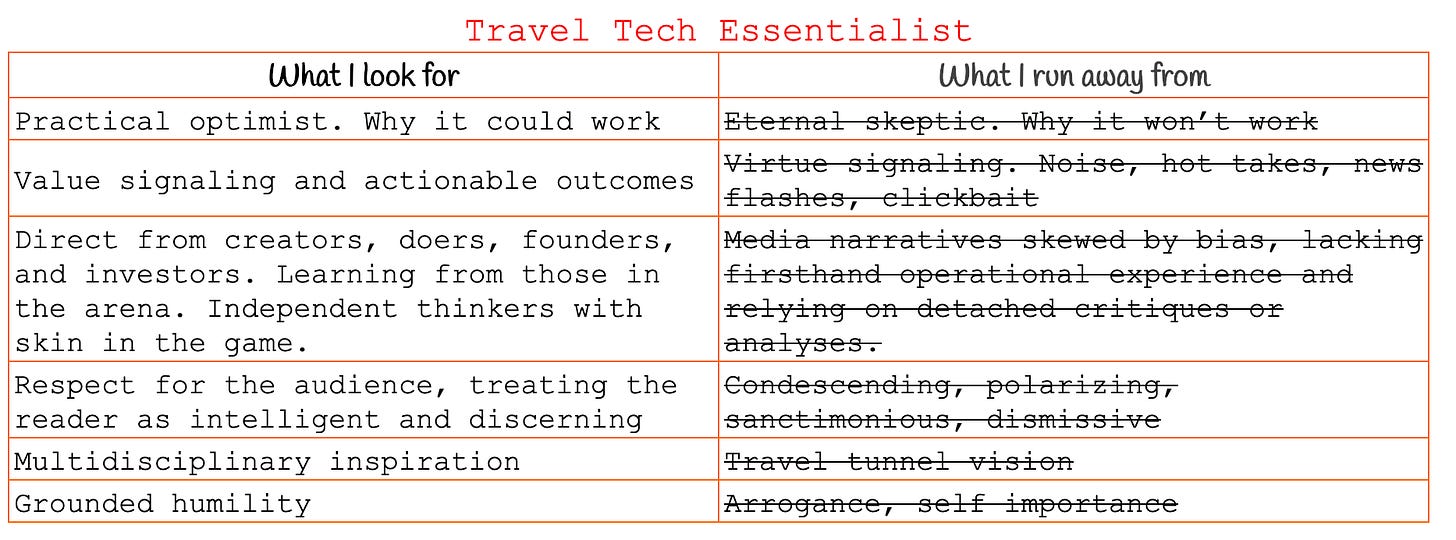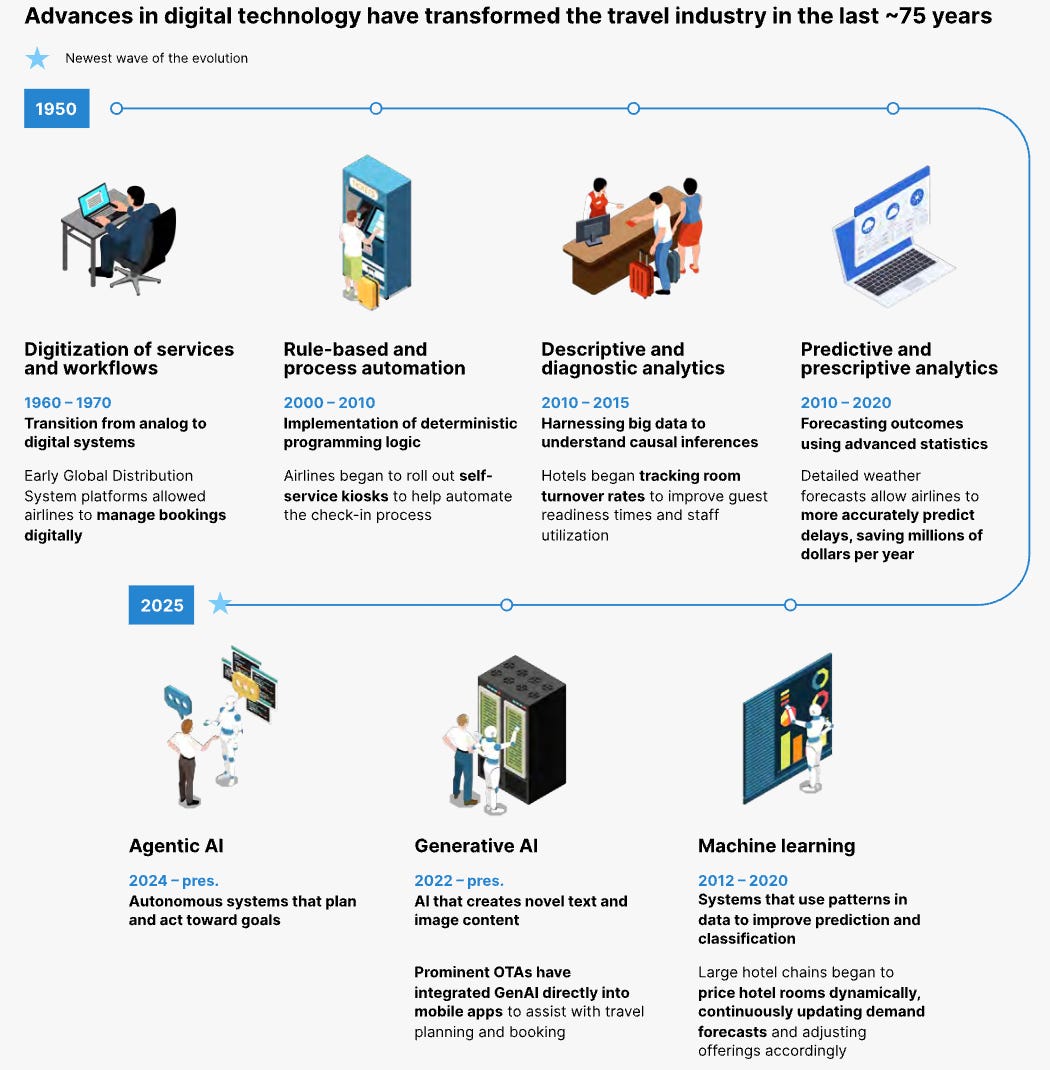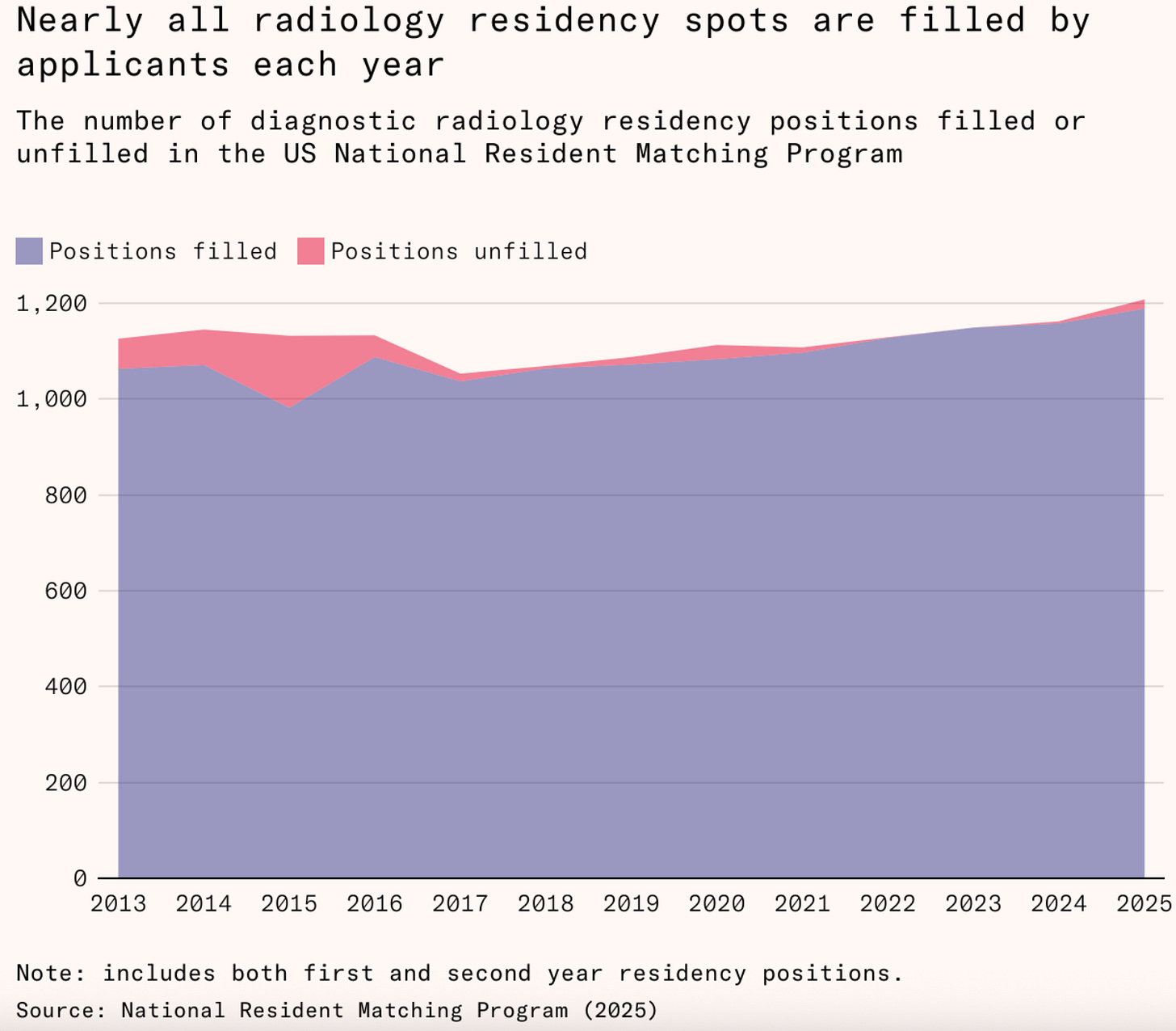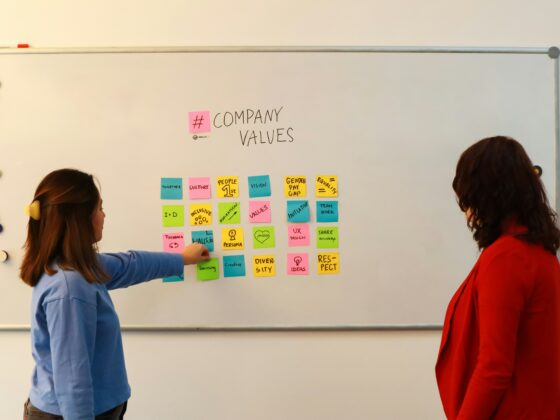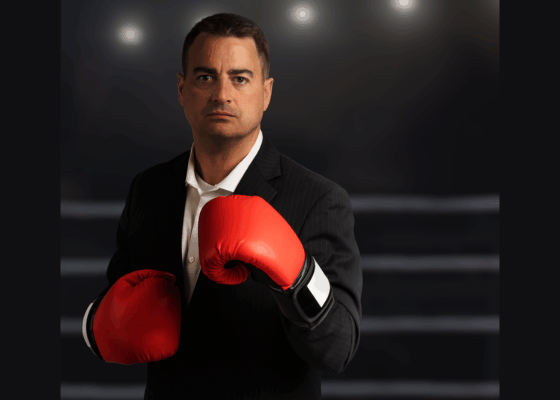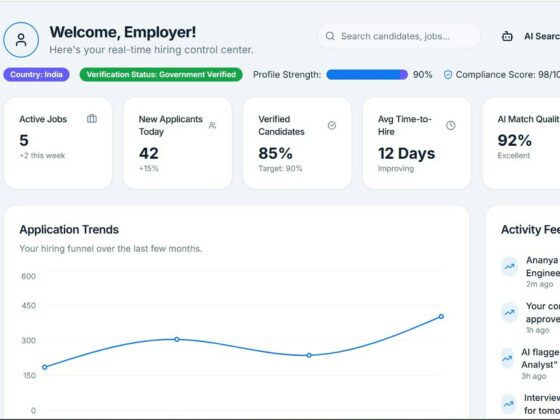Compounding shows up in ways you don’t always measure. A growth loop kicks in. A simple tool quietly brings people in and routes them to the real product. A few words on a button tap into what people actually want. A founder shows up in the final mile and earns trust that lasts. And individual optimism lifts teams and expands what a company is capable of building.
I hope you enjoy this issue.
Special thanks to Propellic for sponsoring this edition of the newsletter:
Is your brand ready for the AI shift in Travel? How are travelers really using Google’s AI Mode?
Propellic’s latest behavioral study, “From Search to Purchase,” offers the first and most precise data yet. It shows a major shift toward operator-direct bookings (~80%) compared to OTAs (13%), and finds that users spend significantly more time planning than booking.
For any brand in the travel industry, this is essential reading. Download the full report here: https://www.propellic.com/research
1. The modern growth hacker
Distribution hacks change every few years. Booking.com perfected SEM. Airbnb growth hacked Craigslist. Zynga rode Facebook’s viral loop. So what’s next? According to a16z’s Speedrun team, it might be clip-farming.
A founder hires a swarm of micro-creators → produces hundreds of short-form content variations → the algorithm finds what hits → scale the winners. One team reportedly spent $2k and got over 10 million views in a week, along with thousands of high-intent downloads.
It’s working because distribution has shifted from follower-based feeds to algorithmic ones. TikTok, Reels, and Shorts reward what works, rather than who you are. That opens the door for low-cost creators to outperform big-budget campaigns.
Like all growth hacks, it won’t last, but this is a window worth testing. Read +
2. Distribution software
If clip-farming is the growth hack of the moment, Greg Isenberg argues the next playbook is distribution software.
For example, a Chrome extension that hides the cringey motivational posts on LinkedIn and quietly links users to a $49/month developer tool. A salary calculator that goes viral on Reddit and drives 40% of leads to an HR SaaS. An AI selfie-to-Renaissance filter that attracts millions of users and funnels them to an API business underneath. None of these tools are the “real” product, but they become distribution.
Now imagine the same approach in travel:
-
Lost Luggage Odds → shows your chance of losing a bag on your route (feeds into travel insurance or smart luggage).
-
Holiday Crowd Forecaster → predicts how busy a destination will be using TikTok mentions and flight data (feeds into a discovery or trip-planning tool).
-
Travel Inbox Miner → scans your Gmail and shows how much you’ve spent on flights and hotels this year (routes into a rewards or smarter booking product).
-
Trip Count → scans your Gmail/calendar and counts how many days you’ve spent away from home (ties into a loyalty program, or wellness product).
-
Delay Survivor Badge → tells you how many hours you’ve lost to delays across past flights (funnels into insurance, lounge memberships, or premium booking services).
Each one is quick to build, instantly shareable, and quietly routes people back to your core product.
The future of marketing is shipping software that markets itself. Software that spreads. Software that people actually want to use, even if just for thirty seconds. — Greg Isenberg
3. Your pitch probably needs more bragging
Andrew Chen (a16z) shared a no-nonsense breakdown of what early-stage founders get wrong in their pitches. Here’s a summary of his sharp and tactical advice:
-
Most startup ideas sound boring. The magic is in the “why?” What’s the surprising, provocative, assertive and attention-grabbing statement you can make at the very beginning of the pitch?
-
Brag more than you think, especially on your team (with numbers)
-
Always include some form of traction, even if it’s just quotes, comps, or some sharp insight. It helps people imagine what you might be able to do.
-
A good demo shows one precise moment of value. A bad one shows a bunch of screens and hopes it makes sense
-
The story should be simple, but not generic
He shared it ahead of Speedrun, a16z’s program for brand-new startups. The deadline for the next cohort is now passed, but applications received now will be considered for the following cohort. They invest up to $1 million and pair you with operator support across GTM, recruiting, capital, and even visa assistance.
4. Optimism as human capital
Dan Wang asks whether innovation is “in human nature.” His answer is no: people innovate when they’re inspired, not because it just happens on its own. He argues that innovation comes from imagination and exposure to ideas that push people to create. That makes optimism, imagination, and belief in the future a form of human capital, as real as skills or experience. When you’re hiring, look for people who carry that sense of possibility. Optimists expand what your company can build. Read + Dan Wang
This lines up with one of the core principles of this newsletter: practical optimism:
5. Agentic AI: from advice to action
Generative AI answers questions and agentic AI gets stuff done. A new McKinsey report outlines how travel companies might move beyond pilots and copilots to AI that executes: rebooking flights, assigning rooms, managing pricing, even fixing their own legacy systems. The report is upfront about the challenge that most travel companies aren’t ready to scale agentic AI, and the biggest wins may come from internal workflows first.
6. The final mile is the real test
In hisImplications newsletter, Scott Belsky wrote that how you show up in the final mile is what really defines you as a leader. It’s easy to look like a good leader when things are going well. Most of us know how to do the right things when the pressure’s low. But the real test is the final mile, right before a launch, an acquisition, an IPO, or a shutdown. This is the mile where decisions move fast, money shifts, and incentives misalign. It’s also when founders have real power: to shape outcomes, shift equity, protect/benefit the team…or not. As Scott Belsky puts it: do what you want to remember doing 10 years later when you look every team member in the eye (or try to hire them again!). I saw this kind of leadership up close at eDreams through PE exits, restructurings, M&A, the IPO, and everything in between. Massive credit to Javier Pérez-Tenessa for how he navigated those final miles with clarity, integrity, and genuine care for the team. It left a mark on me.
Many leaders overestimate their own importance and undervalue their team in the final mile when they negotiate deal structure and determine salaries and titles. No matter what you hear, the truth is that vesting can be accelerated, cap charts can be tweaked, and founders are often empowered to do the right thing for their teams (and ultimately for their own pride and reputation in the long term)…if they make it a priority. How a founder operates at such moments reveals so much. Scott Belsky – Implications
7. Airbnb’s next chapter
At the Goldman Sachs Communacopia + Technology Conference this month, Brian Chesky outlined where Airbnb is headed. His ambition is to take Airbnb from being the Kleenex of vacation rentals to a platform that touches every part of travel and local living. The short version:
-
Beyond rentals. Airbnb wants to be a platform for travel and living: homes, hotels, longer-term stays, services, and experiences. Similar to how Amazon started with books, then expanded into everything.
-
AI-native, not AI-added. Chesky argues most apps today just add AI onto old interfaces (including ChatGPT). He sees it as a pre-AI design with a jet engine behind it. Airbnb’s goal is to build one of the first truly AI-native consumer apps…an “AI concierge” for travel and daily life.
-
Community over transactions. Chesky argues that social media went from connection to performance. His aim for Airbnb is to feel closer to a real-world network where people connect with places, services, and communities.
8. Winning at AEO (Answer Engine Optimization)
SEO is shifting fast. Users are shifting from Google searches to asking LLMs, and getting your product cited within AI answers (“answer engine optimization” or AEO) is the new game. In a recent Lenny’s podcast, Ethan Smith (CEO of Graphite) gives some concrete advice.
-
Early-stage founders can win. With SEO, you usually need domain authority before you get traffic. With AEO, you can show up immediately if your product gets cited in the sources LLMs treat as high-signal, such as Reddit, YouTube, Wikipedia, or well-linked blogs.
-
Mentions matter more than rank. On Google, being the #1 link means you win. In an AI answer, what matters is frequency of citations. If you’re mentioned five times across sources, you’re more likely to appear in the summary.
-
LLM traffic converts better. Ethan shared data from Webflow: leads from LLM answers converted 6x better than leads from Google search because users arrive pre-qualified after asking multiple follow-ups.
-
Focus your efforts. On-site: cover not just the main query (“how can an airline launch a flight subscription?”) but also the follow-ups (“does it integrate with Amadeus?” “can it plug into loyalty programs?”). Off-site: be cited in industry blogs, YouTube, Reddit. Authentic contributions on Reddit are especially powerful.
-
Experiment. Most AEO “best practices” floating around are wrong. Track your share of voice in LLMs, run small experiments (i.e. post helpful answers on Reddit vs. launch a YouTube explainer), and measure what actually moves the needle.
9. Why AI could lead to job growth
Radiologists have long been the classic example of a job AI was “sure” to wipe out. The logic being that scans are digital, tasks are repeatable and benchmarks are clear, creating the perfect conditions for AI to take over.
But as Deena Mousa explains in AI isn’t replacing radiologists, the opposite has happened. AI models can now read scans faster and cheaper than humans, yet demand for radiologists is at record highs. Efficiency lowered the cost of imaging, so hospitals did more of it. The easier and cheaper it became, the more people wanted it.
That’s Jevons paradox in action; when productivity goes up, demand expands instead of shrinking. Travel has seen the same dynamic. When low-cost airlines and online booking made flying cheaper and easier, demand exploded. AI planning and personalization could do the same. By lowering the “friction cost” of planning trips, it’s likely to expand the overall travel pie, driving growth in tourism jobs, from advisors to local hosts to on-the-ground experiences.
10. Conversion magic in a button
Greg Isenberg wrote about how his agency was stuck at 1.5% conversion. The team tried the usual tweaks until a junior designer asked: “What if we’re thinking about our buttons all wrong?” The CTA read “Book a Call.” But nobody wants more calls. They want ideas. So they changed the button to “Request a Brainstorm.” Conversion jumped to 4.2% overnight. A 180% increase from just three words.
Same with a high-end coffee subscription. The button said “Subscribe Now.” They changed it to “Unlock Your Coffee Journey,” and subscriptions tripled.
The strongest buttons go beyond instructions. They tap into identity and aspiration, showing people who they’ll become. Founders obsess over features and funnels. Sometimes, the next 10x might be hiding in nailing the right words on a button.
Travel Tech Essentialist Job Board
→ Explore all 1305 open roles on the Travel Tech Essentialist Job Board now.
-
Valpas | Head of Partnerships | Paris; Helsinki
-
TravelPerk | People Partner – US | Chicago; Boston | $120k – $150k
-
Fora | Advisor Success Manager | New York City | $90k – $1300k + Equity
-
Airbnb | Senior Market Manager, Mexico | Mexico City | MXN 100k-125k / month
📩 For monthly updates on the latest roles, subscribe to the Travel Tech Jobs newsletter
Raising a round?
If you are a startup looking to raise a round (from pre-seed to Series D), I can help (for free). Travel Investor Network is a private platform where I recommend innovative travel startups to investors and innovators. If you’re interested, please start by completing this form.
If you like Travel Tech Essentialist, please consider sharing it with your friends or colleagues. If you’re not yet subscribed, join us here:
And, as always, thanks for trusting me with your inbox.
Mauricio Prieto
